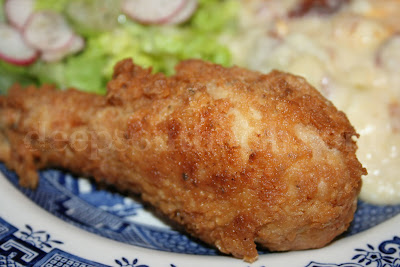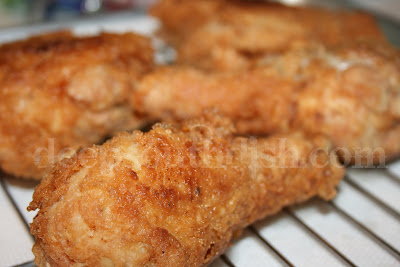Southern fried chicken can certainly be challenging - it just takes practice to be honest! If you're new to frying chicken, try frying only dark or white meat your first time. I also like to brine the chicken first - it really helps to keep the breast meat nice and tender.
Classic Southern Fried Chicken
 Good ol' southern fried chicken. I don't eat it often, but I can't imagine living without it!
Good ol' southern fried chicken. I don't eat it often, but I can't imagine living without it!Admittedly, fried chicken is not an easy dish to get down right without practice - and unfortunately, not something we can eat regularly enough to get that practice - and... frankly, it's a mess.
It's a mess to prep, it's a mess to cook, it's a mess to clean up, and then there's all that oil to contend with afterward too.
Given the fact that we have KFC and Popeye's these days, it's not surprising it really isn't made much at home anymore, but... it is so good, that it is something we Southerners certainly deem worthy of all that trouble - at least on occasion. Besides that... have you seen the price of take out chicken today?
This recipe is a basic fried chicken sans the buttermilk but utilizing a salt brine.
I am a true believer in brining chicken {and pork} so definitely allow time for that step. It produces a tender and juicy fried chicken and is worth the time. Season the chicken pieces with the salt and pepper and allow it to rest in the fridge for at least one hour, two or three if you have the time. You can also add some garlic powder if you like.
Some people would say who needs all that fuss? Our grandma's didn't fuss with a fried chicken like that you might say!
Well, let's not forget how our grandma's acquired said chicken. It's very likely she went right out in the backyard, caught a chicken and well... you know the rest. If they didn't do that, they likely bought a chicken fresh from a chicken farmer up the road. They didn't buy or eat these huge, mass produced, salt bloated chickens like we do these days, and I find that our chickens today need a little bit of help.
As far as frying, I like to use a large chicken fryer, cast iron skillet or my cast iron dutch oven {which will cut down on the splatter factor} and you can't go wrong really if you use a thermometer. You can regulate the temperature so much easier with one and I really think it is a must-have for perfect fried chicken.
Dark meat takes roughly 14 minutes; white meat around 10 minutes, but of course it depends on the size of the pieces too. When cooking mixed chicken, be sure to place the larger, dark meat pieces in the center of the skillet.

For more of my favorite fried chicken recipes, visit my page on Pinterest!
If you make this or any of my recipes, I'd love to see your results! Just snap a photo and hashtag it #DeepSouthDish on social media or tag me @deepsouthdish on Instagram!
Fried Chicken Tips:
Honestly, getting to that perfect fried chicken just really takes making it a few times really. Everything depends on your range (gas or electric), the kind of chicken you're using (whole chicken you cut up, one you buy cut up already or all of the same type of pieces), the type of skillet (stainless, cast iron etc.) But don't let all that scare you. Here are a few tips that might help:
- Maintaining the thermometer at around an average of 300 degrees F roughly is just a good range to shoot for - too much over that and the oil gets too hot and you'll end up with burned crust and undercooked chicken, too much under that and the oil is too cold and you end up with chicken that is greasy. Eventually you get to the point of where you can listen to the oil and the chicken and know when it is ready.
- It takes some practice and knowing your range as far as regulating that temperature. You may need to turn the fire up when you first drop the chicken in and then turn it back down not too long after, before the oil gets too hot.
- Make sure you're not overcrowding your skillet - even with my larger 12 inch cast iron skillet I still do a whole chicken in two batches. There always needs to be plenty of room in the skillet for the oil to bubble up around the pieces. If the pieces are too close together, it will bring the temperature of the oil down too quickly meaning you'll have to cook the pieces longer and they will absorb more oil, making it more greasy.
- Cast iron is good for chicken frying because it distributes the heat more evenly across the skillet with less hot spots, but with an electric range you'll still get those hot spots, usually right in the middle of the skillet. Start with the thighs and legs there, with the bigger part of the leg toward the center of the skillet, breasts next, but while your chicken is frying, keep checking the undersides and rearrange the pieces as needed, moving it to a different part of the skillet or turning it toward the outside of the skillet if its getting too brown.
- Don't be afraid to turn the pieces several times to prevent burning until you get comfortable with the process. Always use tongs to handle the chicken - don't pierce it with forks.
- I also prefer to buy a whole chicken and cut it up myself, but either way, if the breast pieces are super large, which they almost always are anymore these days, cut those evenly in half, so that you end up with four breast pieces instead of two.
- If you have a preference of pieces, you don't have to cook a whole chicken either - just do all breasts or all legs or all thighs, whatever you like. They are usually about the same size so that they cook in about the same time, making it much easier.
- While brining is optional, I highly recommend it. Not only does it improve flavor, add moisture and helps to tenderize, that extra moisture barrier also provides some insurance against overcooking.
Thank you for supporting my work! Please note that Images and Full Post Content including Recipe ©Deep South Dish. Recipes are offered for your own personal use only and while pinning and sharing links is welcomed and encouraged, do not copy and paste post or recipe text to repost or republish to any social media (such as other Facebook pages, etc.), blogs, websites, forums, or any print medium, without explicit prior permission. Unauthorized use of content from ©Deep South Dish is a violation of both the federal Digital Millennium Copyright Act (DMCA) and copyright law. All rights reserved.
Material Disclosure: Unless otherwise noted, you should assume that post links to the providers of goods and services mentioned, establish an affiliate relationship and/or other material connection and that I may be compensated when you purchase from a provider. You are never under any obligation to purchase anything when using my recipes and you should always perform due diligence before buying goods or services from anyone via the Internet or offline.
.



